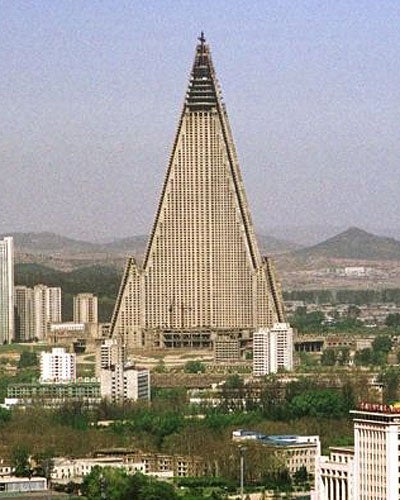North Koreans revamp 'world's worst building'

A hotel in Pyongyang once described as "the worst building in the history of mankind" is back under construction after a 16-year break.
According to foreign residents, the Egyptian conglomerate Orascom has just begun refurbishing the top floors of the pyramid-shaped Ryugyong Hotel, whose 330m (1,083ft) frame dominates the skyline of the capital of North Korea, which is one of the world's most reclusive and destitute countries.
The firm has put glass panels into the concrete shell, installed telecommunications antennae – even though the North forbids its citizens to own mobile phones – and put up an artist's impression of what it will look like. An official with the group said its Orascom Telecom subsidiary was involved in the project, but gave no details. The hotel consists of three wings rising at 75-degree angles capped by several floors arranged in rings, which are supposed to hold five revolving restaurants and an observation deck. A creaky building crane has for years sat unused at the top of the 3,000-room hotel in a city that tourists are only occasionally allowed to visit.
"It is not a beautiful design. It carries little iconic or monumental significance, but sheer muscular and massive presence," Lee Sang Jun, a professor of architecture at Yonsei University in Seoul, South Korea, said.
The communist North started construction in 1987 in a possible fit of jealousy at South Korea, which was about to host the 1988 summer Olympics and show off to the world the success of its rapidly-developing economy. A concrete shell built by North Korea's Paektu Mountain Architects & Engineers emerged over the next few years. A proud North Korea put a picture of the hotel on postage stamps and boasted about the structure in the state media.
According to intelligence sources, the then North Korean leader, Kim Il-sung, saw the hotel as a symbol of his big dreams for the state he founded, while his son and current leader, Kim Jong-il, was a driving force in its construction. But by 1992, work was halted. The North's main benefactor, the former Soviet Union, had dissolved a year earlier and funding for the hotel had vanished. For a time, the North airbrushed images of the Ryugyong Hotel from photographs. As the North's economy took a deeper turn for the worse in the 1990s, the empty shell became a symbol of the country's failure, earning the nicknames "Hotel of Doom" and "Phantom Hotel".
Mr Lee and other architects said there were questions raised about whether the hotel was structurally sound, and a few believed completing the structure could cause it to collapse.
It would cost up to $2bn (£1bn) to finish the Ryugyong Hotel and make it safe, according to estimates in South Korea's media. That is equivalent to about 10 per cent of the North's annual economic output. Bruno Giberti, the associate head of California Polytechnic State University's department of architecture, said the project was typical of what has been produced recently by many cities which were trying to show their emerging wealth by constructing gigantic edifices that were not related in scale to anything else around them.
Mr Giberti, when asked about Esquire magazine's comment about the hotel, said: "If this is the worst building in the world, the runners-up are in [Las] Vegas and Shanghai."
Join our commenting forum
Join thought-provoking conversations, follow other Independent readers and see their replies
Comments
Bookmark popover
Removed from bookmarks